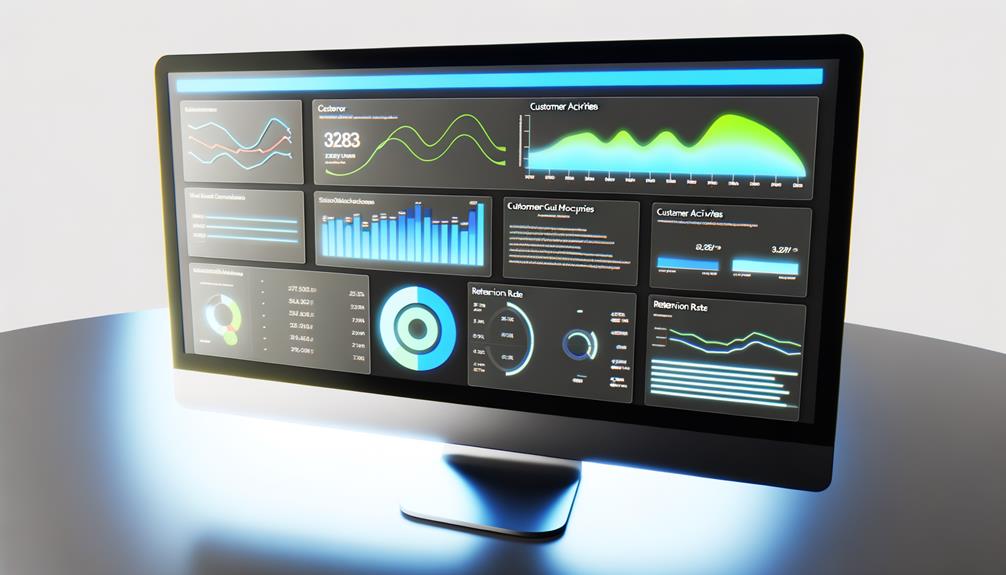In our programmatic SEO efforts, we focus on several key performance indicators. Organic conversions help us measure the tangible results of our strategies. Customer lifetime value (CLV) enables us to see long-term benefits, while cost efficiency, calculated through cost per acquisition (CPA), tells us how economically we're acquiring customers. We also track return on investment (ROI) to make sure our campaigns are profitable. Beyond this, keyword analysis and monitoring organic visibility through tools like SEMrush provide important insights into our website's performance. By mastering these KPIs, you'll gain a detailed view of your SEO success. Continue on, and you'll uncover more insights.
Key Takeaways
- Track organic conversions to measure the direct impact of SEO efforts on user actions.
- Monitor Customer Lifetime Value (CLV) to assess long-term revenue from organic traffic.
- Calculate Cost per Acquisition (CPA) to evaluate the efficiency of SEO campaigns.
- Analyze Return on Investment (ROI) to determine profitability and success of SEO strategies.
- Use keyword rankings and search engine impressions to gauge organic visibility and reach.
Organic Conversions
Tracking organic conversions is vital for quantifying the success of our programmatic SEO efforts in driving meaningful user actions. By focusing on organic conversions as a key performance indicator (KPI), we can demonstrate the tangible results of our strategies in generating valuable leads and sales. The process of tracking and measuring these conversions provides us with a clear view of how effective our SEO campaigns are.
Using tools like Google Analytics, we can directly attribute conversions to our SEO efforts. This not only helps us track the number of conversions but also allows us to analyze the conversion rate—an indicator of how well our site turns visitors into customers. Establishing a benchmark for organic conversions before launching a campaign is important. It sets the stage for measuring success and helps in defining clear goals.
Moreover, monitoring these KPIs allows us to make informed decisions and optimize our programmatic SEO tactics. By understanding which strategies yield the best results, we can refine our approach to maximize both leads and sales. This data-driven focus ensures that our SEO efforts align with our overall business objectives and foster a sense of achievement within our team.
Customer Lifetime Value

Understanding Customer Lifetime Value (CLV) allows us to predict the total revenue each customer will generate over their relationship with our business, providing a long-term view of our SEO efforts' effectiveness. By focusing on CLV, we can gauge the true impact of our SEO strategy beyond immediate conversions, helping us to prioritize initiatives that drive sustainable growth.
Tracking your SEO KPIs through tools like Google Search Console is essential. It enables us to analyze organic traffic and how it contributes to CLV. By examining trends in engine results pages (SERPs) and organic traffic, we can identify which keywords and content creation efforts yield the most loyal and profitable customers. This data-driven approach informs our keyword research, ensuring we're attracting high-value customers rather than just high traffic.
Categorizing our customer base based on CLV allows us to tailor our SEO strategy. We can allocate more resources to the segments generating the most revenue, optimizing our content and keyword targeting to enhance conversion rates. Ultimately, focusing on customer lifetime value as a key performance indicator aligns our SEO efforts with long-term business success, fostering a community of valuable customers who contribute to sustained growth.
Cost and Efficiency

Balancing Customer Lifetime Value with Cost per Acquisition allows us to measure the true efficiency of our SEO campaigns. By calculating the Cost per Acquisition (CPA) as the total SEO cost divided by the number of conversions, we get a clear picture of how much we're spending to acquire each customer. When we compare this cost to the Customer Lifetime Value (CLV), we can determine if our SEO efforts aren't just important but also sustainable in the long run.
Monitoring CPA over time is essential for evaluating the effectiveness of our targeting and content strategies. If we notice a high CPA, it's a signal that our SEO targeting may be off or our content isn't optimized well enough to attract the right audience. This insight allows us to tweak our strategies, ensuring our resources are allocated more efficiently.
Conversions are a significant metric in this context. A high conversion rate with a low CPA indicates that our SEO efforts are well-targeted and optimized. Conversely, a high CPA with low conversions suggests inefficiencies that need immediate attention.
Return on Investment

How do we measure the effectiveness of our programmatic SEO investments if not by calculating the Return on Investment (ROI) to gauge the revenue generated against the costs incurred?
ROI in programmatic SEO is pivotal as it quantifies the revenue gained from our automated optimization strategies. To calculate ROI, we subtract the total costs associated with our programmatic SEO efforts from the generated revenue. This straightforward formula offers a clear snapshot of our financial performance.
Achieving a positive ROI indicates that our programmatic SEO strategies are effectively driving profits. Regularly tracking ROI allows us to evaluate the performance and success of our SEO campaigns with precision. This ongoing evaluation is essential, as it helps us identify which tactics are working and which need adjustment.
Additionally, setting a target ROI is crucial for consistent monitoring. By establishing clear goals, we can fine-tune our automated optimization strategies to maximize our returns. This data-driven approach ensures that every decision we make is backed by concrete metrics, fostering a sense of belonging and shared purpose among our team.
Ultimately, tracking and optimizing ROI isn't just about numbers; it's about aligning our efforts with our broader business objectives.
Organic Visibility and Reach

To gauge our organic visibility and reach, we should prioritize analyzing keyword rankings, tracking search engine impressions, and measuring click-through rates. These metrics provide a detailed picture of how effectively our content is performing in search results.
Using tools like Semrush's Position Tracking, we can monitor these KPIs closely and adjust our strategy to maximize visibility and audience engagement.
Keyword Rankings Analysis
Monitoring keyword rankings provides a critical measure of a website's organic visibility and reach in search results, enabling us to precisely evaluate the effectiveness of our SEO strategies. By tracking keyword rankings, we can gauge our search engine visibility, one of the most important metrics in our SEO KPIs. High keyword rankings often indicate a strong organic presence, which correlates with higher traffic potential and engagement.
Analyzing these rankings allows us to pinpoint optimization opportunities and refine our SEO strategies. For example, if certain keywords are consistently ranking lower, it might signal areas where our content or link-building efforts need improvement. This data-driven approach helps us maintain competitiveness in search results and continue enhancing our organic search results.
Furthermore, evaluating keyword rankings provides insights into the performance of our SEO efforts relative to competitors. Are we gaining ground or losing visibility? This analysis helps us understand the search results competitiveness, guiding our strategy adjustments. The ultimate goal is to see a positive trend in our keyword rankings, reflecting a growing organic presence and improved search engine visibility. Keeping a close eye on these important metrics is vital for sustained SEO success.
Search Engine Impressions
Tracking search engine impressions gives us a quantifiable measure of our website's visibility and reach in organic search results. These impressions reflect the number of times our site appears in search results, providing a clear indicator of our organic search presence. By analyzing these key metrics, we can evaluate the effectiveness of our SEO strategies and determine how well our content is performing in driving brand exposure.
When we see an increase in search engine impressions, it signifies that our optimization efforts are enhancing our search visibility. This uptick in visibility directly correlates with potential customer engagement, as more users are exposed to our brand. Programmatic SEO thrives on such data, enabling us to fine-tune our approach and make sure that our content reaches a broader audience.
Monitoring search engine impressions isn't just about numbers; it's about understanding the impact of our SEO KPIs on our overall digital strategy. By regularly reviewing and analyzing these insights, we can make informed decisions that drive continuous improvement.
As a community focused on achieving excellence in SEO, let's leverage these impressions to maximize our organic reach and solidify our brand's presence in the competitive digital landscape.
Click-Through Rate
Building on our analysis of search engine impressions, we now turn our focus to Click-Through Rate (CTR), a pivotal metric that measures the percentage of users who click on our search results after seeing them. CTR is instrumental in gauging organic visibility and searchers' engagement, making it a cornerstone of Programmatic SEO.
Higher CTR signifies that our meta tags, titles, and descriptions are effectively capturing the interest of users, leading to increased organic traffic. By monitoring and optimizing CTR, we can refine our SEO strategies to guarantee they resonate well with our audience, driving more clicks and enhancing organic reach.
Let's examine some key aspects of CTR:
| Aspect | Importance | Optimization Strategies |
|---|---|---|
| Meta Tags | Essential for click appeal | Use relevant keywords and clear messaging |
| Titles | Vital for first impressions | Craft compelling and concise titles |
| Descriptions | Enhances relevance and engagement | Provide informative and engaging content |
| Search Results | Reflects searcher engagement | Test and iterate for best performance |
Keyword Analysis

When we conduct keyword analysis, we focus on search volume trends to understand user demand and behavior changes.
We also evaluate keyword difficulty metrics to gauge the competitiveness of our target terms.
Search Volume Trends
Analyzing search volume trends allows us to pinpoint popular keywords that can greatly enhance our optimization efforts. By examining keyword search volume fluctuations, we can tailor our content creation strategies to align with current and emerging trends.
Utilizing tools like SEMrush offers invaluable insights into keyword search trends, helping us identify high search volume keywords that indicate relevance and potential traffic.
To effectively track and leverage search volume trends, we should focus on the following:
- Identify High Search Volume Keywords: These keywords signal what users are actively searching for, guiding us toward content topics that attract significant traffic.
- Monitor Keyword Search Volume Fluctuations: Observing these fluctuations helps us stay agile, adjusting our strategies to capitalize on rising trends or pivot away from declining ones.
- Evaluate Keyword Relevance: Regularly gauging the relevance of our chosen keywords ensures our content remains aligned with user intent, aiding in staying competitive in search results.
Keyword Difficulty Metrics
Understanding keyword difficulty metrics allows us to strategically prioritize our SEO efforts by targeting keywords with high ranking potential and manageable competition. This data-driven approach is essential for refining our SEO strategies and achieving better ranking outcomes.
Keyword difficulty metrics assess the competition level for specific keywords, incorporating factors such as search volume, keyword competition, and relevance. By leveraging automated SEO tools, we can efficiently analyze these metrics, enabling us to identify keywords that offer the best opportunities for ranking. This analysis is vital for prioritizing keyword targeting, ensuring our efforts are focused on terms that can deliver significant traffic with a reasonable investment.
High search volume indicates a keyword's popularity, while keyword competition reveals how many other websites are vying for the same term. Relevance ensures the keywords align with our content and audience intent. By synthesizing these elements, we can uncover keywords with optimal ranking potential.
Incorporating keyword difficulty metrics as part of our SEO KPIs not only streamlines our approach but also enhances our ability to make informed decisions. This strategic focus allows us to allocate resources more effectively, ultimately driving better results and fostering a sense of achievement within our team.
Competitive Keyword Landscape
By dissecting the competitive keyword landscape, we can pinpoint high-value keywords that will elevate our programmatic SEO efforts. This analytical approach allows us to understand competitor keyword strategies and uncover optimization opportunities that drive meaningful results.
Identify High-Value Keywords:
By leveraging tools like Semrush for competitive keyword analysis, we can determine which keywords our competitors are successfully ranking for. This insight helps us target keywords that offer the highest potential for traffic and conversions.
Monitor Competitor Rankings and Trends:
Tracking keyword trends and fluctuations in competitor rankings provides us with a dynamic view of the competitive landscape. This data is essential for adjusting our keyword targeting strategies and ensuring our content stays relevant and competitive.
Analyze Keyword Performance:
Regularly monitoring the performance of our keywords against those of our competitors allows us to refine our programmatic SEO campaigns. This continuous analysis helps us improve our optimization efforts and maintain an edge in the market.
User Engagement

To accurately gauge the effectiveness of our programmatic SEO efforts, we need to closely monitor user engagement metrics such as bounce rate, time on page, and session duration. These metrics are essential for understanding how well our content resonates with visitors.
A high bounce rate indicates that a significant percentage of visitors navigate away after viewing a single page, suggesting issues with content quality or relevance. Conversely, longer time on page and session duration signify that our audience finds value in our content and engages deeply with it.
By analyzing these user engagement metrics, we can pinpoint areas for improvement. If the bounce rate is high, we should reassess the relevance of our programmatic SEO content to make sure it meets the needs and expectations of our target audience.
Similarly, a short time on page might indicate that our content isn't compelling enough to retain visitors' attention. Enhancing the quality of our content will encourage longer session durations, thereby fostering a more engaged user base.
In essence, tracking these metrics allows us to refine our SEO strategies continually, ensuring that we create meaningful, relevant content that resonates with our audience and drives sustained engagement.
Frequently Asked Questions
What KPIS Should Be Measured for Seo?
We should measure organic traffic, bounce rate, page speed, conversion rate, keyword ranking, click-through rate, backlink quality, domain authority, user engagement, and content freshness to thoroughly evaluate SEO performance. These KPIs help us optimize and showcase success effectively.
What Are the KPIS for Programmatic Advertising?
We measure key KPIs like conversion rates, ad spend, click-through, and impression count. Effective audience targeting, ad placements, budget allocation, bidding strategies, ad creatives, and retargeting efforts all contribute to our programmatic advertising success.
How Do I Find Keywords for Programmatic Seo?
To find keywords for programmatic SEO, let's delve into competitor analysis, search volume, and keyword difficulty. We'll explore long-tail keywords and content gaps, considering user intent, seasonal trends, SERP features, and topic clusters for best results.
What Are the SEO KPIS Ie What Factors Determines the Performance in Seo?
We focus on backlink quality, content freshness, bounce rate, conversion rate, organic traffic, search intent, page speed, user engagement, mobile optimization, and indexing status. These KPIs help us analyze and improve our SEO performance thoroughly.
Conclusion
It's worth noting that our key performance indicators for programmatic SEO align perfectly with our strategic goals. These KPIs include organic conversions, customer lifetime value, cost and efficiency, return on investment, organic visibility and reach, keyword analysis, and user engagement.
By monitoring these metrics, we can make data-driven decisions that optimize our campaigns. We've seen firsthand how focusing on these KPIs directly correlates with improved performance and ROI, making our SEO efforts both efficient and impactful.
